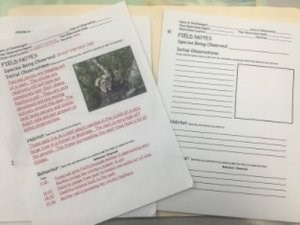Hawk Mountain's Educational Research
Posted on in In the Field by Kirsten Fuller, former education intern

Who was the most influential teacher in your life? In my experience it was my high school English teacher, Mr. Kranz. I was always captivated by his passion for theater and music, and his ability to provide me inspiration in a subject area I typically didn’t care for. I am currently in the last stage of completing my teaching certificate, student teaching at a challenging high school, and it has been a bumpy ride. The daily chaos and mayhem I have had to face as a naive student-teacher has proven to be taxing on my sanity at times.

What has kept me motivated has been the moments in which I’ve had the opportunity to inspire students in the same way my English teacher in high school had inspired me. One of these moments occurred recently when I was invited to teach a lesson on birds and what it means to be a bird scientist for a 7th grade class at Long Valley Middle School.
I began the lesson providing an introduction as to what ornithology entails, and more specifically, what a raptor is. I loved having a simple discussion with these bright 7th graders about the characteristics that make birds-of-prey different from songbirds. Borrowing materials such as talons, skulls, and wings, from Hawk Mountain’s education department, majorly enhanced my lesson. We were even able to look at Great Horned Owl and Red-tailed Hawk feathers under a digital microscope to observe the differences!

To inspire and engage my students, I wanted them to get the experience of what it means to actually be an ornithologist. Using my own experience as a scientist conducting nest observations in real life, I designed an activity to allow students to conduct nest observations using a computer.
Using YouTube, I found a video of a Great Horned Owl nest camera. Then, I created a “Field Notes” worksheet for students to complete as they watched the video. They took observations on the sights and sounds, they drew a picture, they described the habitat, and they took behavioral observations. I was so excited about how engaged in the activity every student was.

At the end of the lesson, students got time to share their drawings and their observations on the board. I loved watching how excited they were to share their thoughts and their artistic abilities with the class.
Fast forward to my Monday-morning reality: after a fleeting stint with a utopian 7th grade classroom, I am re-immersing myself in my intimidating high school classroom. However, I have gained a new perspective, and have developed new motivation to share how much I love science with my students.
High school biology class should not be about fulfilling science standards or preparing students for standardized tests; it should be about exploring current scientific research and learning about the natural environment around us. I believe my time spent as an education intern at Hawk Mountain opened my eyes to this style of teaching. I plan to continue tackling the teaching challenges I am faced with daily with this in mind.
-------
Learn more about Kirsten Fuller's successful work with the creation of Hawk Mountain's new technology-interactive broadwing curriculum, using Hawk Mountain tracking data, by checking out the Teacher Feature on the New Jersey Science Teachers Association website!